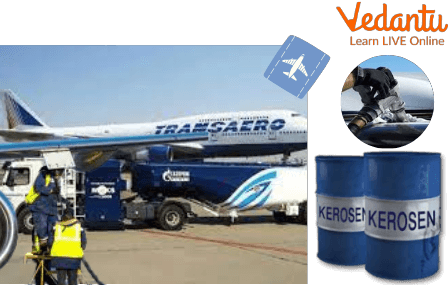




Overview of Jet Fuel
The aeroplanes we so often use to travel use a separate kind of fuel. The energy content and combustion quality of jet fuels are important to fuel performance characteristics because the primary purpose of aviation turbine fuel (also known as jet fuel) is to power aircraft. Other essential performance characteristics include cleanliness, lubricity, fluidity, volatility, and non-corrosivity.
Acute access to jet fuels has been linked to neurologic consequences in people, including narcosis, gait abnormalities, headaches, nausea, vomiting, dizziness, exhaustion, and issues with coordination and balance—so many things to know about in the article. Let’s dive right in!
What is Jet Fuel?
Jet fuel, often known as aviation turbine fuel (ATF), or avtur, is a kind of aviation fuel made for gas turbine-powered aircraft. It appears colourless to straw-coloured. The fuels Jet A and Jet A-1, manufactured to a defined worldwide specification, are most frequently used in commercial aviation. Other than Jet B, which is used for its improved cold-weather performance, there are no other jet fuels frequently used in commercial turbine-engine-powered aviation.
Jet fuel is a complex blend of many different hydrocarbons. The specifications for the item, such as its freezing or smoke point, specify the range of its sizes (molecular masses or carbon numbers).

Jet Fuel used in Aviation
What Fuel is Used in an Aeroplane?
The majority of aircraft use kerosene fuel, except for the ones with piston engines. There are numerous formulae available, with Jet A-1 being the most popular. It is used in the majority of jet-powered aircraft and is also known as JP-1A. Kerosene makes up the majority of Jet A-1, with a little amount of additives. These chemicals act as preservatives to guard against damage to aircraft engines.
Kerosene fuel is used by aircraft for a number of purposes. First of all, kerosene is said to be less volatile than regular gasoline. Kerosene has a flashpoint roughly equal to 100 degrees Fahrenheit, which means that it won't ignite unless it is subjected to temperatures higher than 100 degrees Fahrenheit. Kerosene's freezing point is also lower than gasoline. Kerosene won't freeze until it reaches a -22 Fahrenheit temperature.
Because aeroplanes fly at such high altitudes, a low freezing point is crucial. The cruising altitude of the majority of commercial aircraft is between 33,000 and 42,000 feet above sea level. The air becomes substantially colder than the air close to the ground at this altitude. Kerosene can tolerate these severe climatic conditions without freezing because of its low freezing point. Petrol is less lasting than kerosene.

Aeroplane Getting Fuelled
Uses of Jet Fuels
Jet fuels are used in various aviation activities. They are one of the types of aviation fuels; let’s have a look at the uses:
Turbine Motors: The turbines and piston motors that keep jets, as well as other aeroplanes, in the air and flying safely are powered by jet fuel.
Kerosene: In America, kerosene has been used as a heat source in portable stoves, barbecues, and space heaters for centuries. In the current world, underprivileged nations continue to use kerosene.
Lighting: Kerosene, which is essentially what jet fuel is, is also used to light lamps and lanterns. Kerosene vapours can be highly explosive when combined with air; hence lamps and lanterns must always be kept closed.
Summary
In this article, we learned about various uses of jet fuel. When choosing a fuel for an aircraft, specific energy is a crucial factor. Aircraft in flight using electric cells as the motive power energy store have not yet been commercially feasible for even tiny personal aircraft due to the significantly greater energy storage capacity of hydrocarbons compared to batteries.
We also learned that petroleum-based fuels or blends of petroleum and artificial fuel are referred to as aviation fuels and are used to power aeroplanes. They are subject to stricter regulations than fuels used for fixed purposes, such as heating and driving, and they contain additives to improve or preserve characteristics vital to fuel management or performance.
FAQs on Uses of Jet Fuel
1. Is diesel and jet fuel interchangeable?
Diesel and Jet-A still have a few significant distinctions. To begin with, Jet-A contains more sulphur and other additives than is permitted in your diesel, including cetane and the cetane number. This may result in fines and possibly harm to your engine.
2. Can vehicles run on jet fuel?
Only diesel engines can run on jet fuel in automobiles. Diesel and kerosene jet fuel are comparable enough to work together and have comparable performance. However, we wouldn't advise using diesel to power a jet.
3. Does gasoline burn more cleanly than jet fuel?
E-Jet provides the same performance and quality, is certified, and is ready for drop-in installation, but its lifecycle emissions are over 90% lower. This is because we get our fuel's carbon from the air and not the earth, and it burns cleaner than fuels derived from petroleum since it has fewer impurities.
4. Who burns up the most jet fuel?
California consumes more jet fuel compared to any other state (17% of the national total in 2019), and from 2010 to 2019, the state's usage climbed by 37%. Jet fuel usage rose by 52% in Washington, 37% in Hawaii, and 35% in Oregon.









